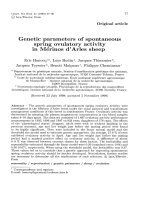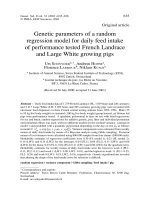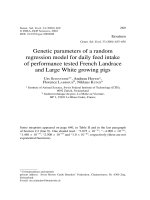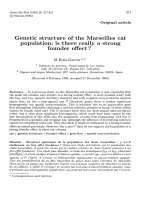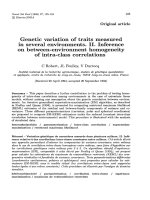Báo cáo sinh học: " Genetic parameters of body weight, egg production and shell quality traits in the Brown Tsaiya laying duck" potx
Bạn đang xem bản rút gọn của tài liệu. Xem và tải ngay bản đầy đủ của tài liệu tại đây (750.47 KB, 14 trang )
Original
article
Genetic
parameters
of
body
weight,
egg
production
and
shell
quality
traits
in
the
Brown
Tsaiya
laying
duck
YS
Cheng
R
Rouvier
JP
Poivey
C Tai
1
Institut
national
de
la
recherche
agronomique,
station
d’amélioration
génétique
des
animaux,
centre
de
recherches
de
Toulouse,
BP
27,
F
31326
Castanet-Tolosan
cedex,
France;
2
Taiwan
Livestock
Research
Institute,
Hsin-Hua,
Tainan,
71210
Taiwan,
Republic
of
China
(Received
13
June
1994;
accepted
1st
June
1995)
Summary -
Heritabilities
and
genetic
correlations
were
estimated
for
5 575
laying
Brown
Tsaiya
ducks
on
performance
data
from
5
generations
of
a
selection
experiment,
by
means
of
a
multivariate,
multimodel,
restricted
maximum
likelihood
method
(MM-REML)
applied
to
an
animal
model
on
the
12
traits:
feather
length
at
20
weeks
of
age
(FL20);
body
weight
at
20
and
40
weeks
of
age
(BW20;
BW40);
age
at
first
egg
(AGElEGG);
number
of
eggs
laid
up
to 40
and
52
weeks
of
age
(NEGG40;
NEGG52);
eggshell
strength
at
30
and
40
weeks
of
age
(ES30;
ES40);
egg
weight
at
30
and
40
weeks
of
age
(EW30;
EW40);
egg
yolk
weight
at
40
weeks
of
age
(EYW40);
and
the
proportion
of
egg
weight
to
body
weight
at
40
weeks
of
age
(EW40/BW40).
Adult
females
were
heavier
than
adult
males
(BW40:
1391
g vs
1 310
g).
ES40
was
lower
than
ES30
(3.5
kg/cm
2
vs
3.8
kg/
CM
2.
Heritabilities
were
found
to
be
low
(0.094,
0.107, 0.118, 0.160,
0.169,
0.191
and
0.201
for
ES40,
ES30,
NEGG52, NEGG40,
FL20,
EYW40
and
AGE.1EGG,
respectively),
to
medium
(0.327,
0.329,
0.353,
0.425
and
0.499
for
EW40/BW40,
EW40,
EW30,
BW20
and
BW40,
respectively).
Fifty
genetic
correlations
were
tabulated.
The
pattern
of
the
genetic
correlations
for
the
traits
to
be
selected
showed
that
NEGG52
was
highly
positively
correlated
with
NEGG40
(rg
=
0.948),
uncorrelated
with
the
body
weight
and
was
negatively
correlated
with
AGELEGG
(rg
=
-0.749),
EW40
(rg
=
-0.323),
EW30
(rg
=
-0.200),
EYW40
(rg
=
-0.340),
ES30
(rg
=
-0.194),
ES40
(rg
=
-0.203),
FL20
(rg
=
-0.131)
and
EW40/BW40
(rg
=
-0.259).
Egg
weights,
body
weights
and
eggshell
strength
traits
were
positively
genetically
correlated
among
themselves.
The
results
suggest
that
a
linear
selection
index
for
NEGG52
with
constraints
for
EW40,
BW40
and
ES40
could
be
an
efficient
tool
for
improving
the
efficiency
of
egg
production
with
this
small
body
type
laying
duck.
heritability
/
genetic
correlation
/
animal
model
/ laying
duck
*
Correspondence
and
reprints
Résumé -
Paramètres
génétiques
des
caractères
de
poids
corporels,
de
produc-
tion
d’oeufs,
et
de
qualité
de
la
coquille
chez
la
cane
pondeuse
Tsaiya
Brune.
Les
héritabilités
et
corrélations
génétiques
ont
été
estimées
pour
5 575
pondeuses
Tsaiya
Brune,
sur
la
base
de
performances
concernant
les
5
premières
générations
d’une
expérience
de
sélection
par
la
méthode
du
REML-MM
(maximum
de
vraisemblance
restreinte-multivariate
multimodèle)
appliquée
à
un
modèle animal
sur
12
caractères :
la
longueur
de
la
plume
à
l’âge
de
20
sem
(FL20),
le
poids
corporel
à
20
et
40
sem
(BW20 ;
BW40),
l’âge
au
premier
ceuf
(AGEIEGG),
les
nombres
d’ceufs
à
40
et
52
sem
(NEGG40;
NEGG52), la
solidité
de la
coquille
à
30
et
40
sem
(ES30 ;
ES40),
le
poids
des
ceufs
à
30
et
40
sem
(EW30 ;
EWl,O),
le
poids
des
jaunes
d’oeufs
à
40
sem
(EYWl!O)
et
le
rapport
du
poids
de
l’ceuf
au
poids
corporel
à
40
sem
(EW401BW40).
Les
femelles
adultes
étaient
plus
lourdes
que
les
mâles
(BW40 :
1 391
vs
1 310
g).
ES/0
était
inférieure
à
ES30
(3,5
vs
3,8
kg/cm
2
).
Les
valeurs
d’héritabilité
dES4
0,
ES30,
NEGG52, NEGG40,
FL20,
EYW40
et
AGE1EGG
étaient faibles :
0, 094 ;
0,107 ;
D,118 ;
0,160 ;
0,169 ;
0,191
et
0, 201
respec-
tivement.
Elles
étaient
de
0,327;
0,329 ;
0,353 ;
0,425
et
0,499 pour
EW40/BW4
0,
EW40,
EW30,
BW20
et
BW40.
Cinquante
corrélations
génétiques
sont
tabulées.
NEGG52
était
fortement
corrélé
avec
NEGGl,O
(rg
=
0, 948),
mais
n’était
pas
corrélé
avec
les
poids
cor-
porels
et
était
corrélé
négativement
avec
AGEIEGG
(rg
=
-0, 749),
EW40
(rg
=
-0, 323),
EW30
(rg
= -0, 200),
EYW40
(rg
=
-0, 340),
ES30
(rg
=
-0,194),
ES40
(rg
=
-0, 203),
FL20
(rg
= -0,131)
et
EW40/BW40
(rg
=
-0, 259).
Les
poids
des
ceufs,
les
poids
cor-
porels
et
les
caractères
de
la
solidité
de
la
coquille
étaient
positivement
corrélés
entre
eux.
Les
résultats
suggèrent
qu’une
sélection
sur
un
inde!
linéaire
pour
NEGG52
avec
des
con-
traintes
pour
EW40,
B W4
et
ES4
0
pourrait
être
efficace
pour
améliorer
les
performances
de
la
production
d’oeuf
de
la
cane
Tsaiya
Brune.
héritabilité
/
corrélation
génétique
/
modèle
animal / cane
pondeuse
INTRODUCTION
Twelve
traits
relating
to
feather
length,
body
weights,
egg
production,
egg
weights
and
eggshell
quality
have
been
recorded
in
a
selected
Brown
Tsaiya
laying
duck
strain
(L105)
at
the
Duck
Research
Center,
Ilan,
Taiwan
Livestock
Research
Institute
since
1984
(Tai
et
al,
1994).
Not
much
is
known
about
the
genetic
parameters
and
especially
the
genetic
correlations
for
these
traits
in
ducks.
Tai
et
al
(1989)
estimated
heritabilities for
8
of
these
traits
in
the
first
generation.
Lee
et
al
(1992)
estimated
genetic
parameters
in
each
of
the
first
4
generations,
using
variance
component
estimation
method
applied
to
a
hierarchical
relationship
structure.
On
the
other
hand,
the
best
linear
unbiased
prediction
(BLUP)
(Henderson,
1988)
has
been
increasingly
applied
to
an
animal
model
for
predicting
the
genetic
merit
of
candidates
for
selection
in
most
species
of
farm
animals.
For
this
purpose
estimates
of
the
genetic
parameters
in
the
base
population
are
required.
Some
simulation
research
has
shown
that
the
use
of
maximum
likelihood
(ML)
or
minimum
variance
quadratic
unbiased
estimation
(MIVQUE)
methods
on
selected
data
can
lead
to
unbiased
estimates
of
additive
genetic
variance
in
the
base
population
(Rothschild
et
al,
1979;
Meyer
and
Thompson,
1984;
Sorensen
and
Kennedy,
1984).
It
has
been
shown
that
when
the
method
of
restricted
maximum
likelihood
(REML,
Patterson
and
Thompson,
1971)
is
applied
to
an
animal
model,
in
particular
when
all
the
information
contributing
to
selection
is
included
in
the
analysis
and
a
large
number
of
additive
loci
is
assumed,
it
can
provide
unbiased
estimation
in
selected
populations
(Kennedy,
1990;
Meyer,
1990,
1991).
Consequently,
REML
has
recently
been
applied
in
animal
breeding
for
estimating
variance
and
covariance
components
in
selected
populations
(Hofer
et
al,
1992;
Besbes,
1993;
Ducos
et
al,
1993;
Hagger,
1994;
Mielenz
et
al,
1994;
Poujardieu
et
al,
1994).
As
far
as
we
know,
it
has
not
yet
been
used
to
estimate
genetic
parameters
in
laying
ducks.
The
purpose
of
this
study
was
to
estimate
and
discuss
genetic
parameters
for
the
12
traits
recorded
for
the
first
5
generations
in
a
selection
experiment
for
laying
Brown
Tsaiya
ducks.
MATERIALS
AND
METHODS
Data
description
The
ducks
were
collected
from
4
different
locations
around
Taiwan.
Sires
came
from
4
breed
farms
and
dams
from
another
4
egg-production
farms.
With
4-by-4
mating,
each
origin
of
sire
was
mated
to
the
4
origins
of
dams
(5
ducks
per
drake)
and
then
progeny
was
assigned
to
mating
groups
depending
on
the
sire
origins.
Twelve
traits
were
individually
measured
and
recorded
as
follows:
FL20:
feather
length
at
20
weeks
of
age
(except
in
2nd
and
4th
generations)
in
both
sexes.
BW20,
BW40:
body
weight
at
20
and
40
weeks
of
age
respectively
in
both
sexes.
AGE1EGG:
age
at
first
egg.
NEGG40,
NEGG52:
number
of
eggs
laid
up
to
40
and
52
weeks
of
age,
respectively.
ES30:
eggshell
strength
at
30
weeks
of
age
(except
in
4th
and
5th
generations).
ES40:
eggshell
strength
at
40
weeks
of
age
(except
in
1st
and
2nd
generations).
EW30,
EW40:
egg
weight
at
30
and
40
weeks
of
age,
respectively.
EYW40:
egg
yolk
weight
at
40
weeks
of
age
(except
in
first
generation).
EW40/BW40:
the
ratio
of
egg
weight
to
body
weight
at
40
weeks
of
age.
Eggs
laid
over
5
consecutive
days
at
30
and
40
weeks
of
age
were
weighed
and
measured
by
eggshell
strength
meters
for
the
average
of
EW30, EW40,
ES30
and
ES40.
The
structure
of
the
selection
experiment
(without
control
strain)
is
described
in
table
I
for
the
number
of
ducks
(males
and
females)
and
the
hatching
date
of
each
generation.
Population
size
was
increased
from
the
third
generation
mainly
in
order
to
maintain
an
optimal
population
size
for
long-term
selection
(Lee
et
al,
1992).
A
2-stage
selection
was
carried
out.
First,
50%
of
the
female
ducks
were
selected
on
a
linear
phenotypic
selection
index:
Among
these
selected
females,
the
top
50%
were
selected
for
ES30
(first
and
second
generations)
or
ES40
(third
to
fifth
generations).
The
drakes
were
similarly
chosen
taking
into
account
the
performances
of
their
full
and
half
sisters.
Statistical
analysis
All
records
were
analysed
by
an
SAS
univariate
procedure
to
test
normal
distribu-
tion,
and
some
extreme
and
abnormal
data
were
discarded
(less
than
3
depending
on
the
trait).
Skewed
distributions
were
observed
for
the
AGE1EGG,
NEGG40
and
NEGG52
variables.
They
were
thus
transformed
using
a
power
distribution
(Box
and
Cox,
1964;
Besbes
et
al,
1993)
in
order
to
satisfy
the
classical
hypotheses
for
normally
distributed
traits.
This
transformation
relies
on
a
single
parameter
t
as
shown
previously
for
laying
hens
(Ibe
and
Hill,
1988;
Besbes
et
al,
1992).
The
following
formula
was
used:
where !
is
the
geometric
mean
of
the
original
observations.
The
parameter
t was
empirically
chosen
is
such
a
way
that
skewness
became
close
to
zero
and
there
was
a
low
residual
sum
of
squares
in
the
genetic
model
used
to
describe
the
data.
The
t
values
were
3.8,
3.0
and -1.2,
respectively,
for
NEGG52,
NEGG40
and
AGE1EGG.
Analysis
of
FL20,
BW20
and
BW40
was
based
on
the
following
linear
model:
where
for
AGEIEGG,
NEGG40, NEGG52,
ES30,
ES40,
EW30, EW40,
EYW40
and
EW40/BW40
the
following
model
was
used:
where
y2!xl
and
Yi
kl
are
the
ijklth
and
iklth
observations
respectively, !
is
the
population
mean,
H
is
the
fixed
effect
for
the
ith
hatch,
S
is
the
fixed
effect
for
the
jth
sex,
az!x
and
a
ix
are
the
random
additive
genetic
effects
of
the
ijkth
and
ikth
animals
respectively,
and
e2!xl
and
e
iki
are
the
residual
effects.
Sires
from
the
4
origins
were
considered
to
belong
to
the
same
population.
The
data
for
the
4
lines
were
pooled.
Heritabilities
and
genetic
correlations
were
estimated
by
the
restricted
maximum
likelihood
method
(REML)
applied
to
an
animal
model.
A
derivative-free
REML
algorithm
(Graser
et
al,
1987)
from
the
DF-
REML
program
of
Groeneveld
and
Kovac
(1990a,b)
as
adapted
by
Boichard
(1994)
and
the
VCE
multivariate
multimodel
REML
(co)variance
component
estimation
(MM-REML)
program
of
Groeneveld
(1994a)
were
used
for
all
trait
analyses.
Computing
strategy
The
general
linear
model
is
as
follows:
where
y
=
vector
of
observations
for
the
trait;
(3
=
vector
of
fixed
effects;
u
=
vector
of
animal
effects;
e
=
random
vector
of
residual
effects;
X,
Z
are
incidence
matrices
relating
observations
to
the
effects
in
the
model,
G
=
A
(9
Go;
A
is
the
numerator
relationship
matrix;
Go
is
the
(co)variance
matrix
for
additive
genetic
effects
among
traits;
R
=
Le
®
Rro;
Ie
is
the
identify
matrix;
Ro
is
the
residual
(co)variance
among
traits;
(9
=
the
Kronecker
product.
The
mixed-model
equations
(MME)
are
then
(Henderson,
1963,
1973):
The
logarithm
of
the
restricted,
multivariate,
normal
likelihood
function
to
be
maximized
is
as
follows
(Groeneveld,
1994b):
where
LV
is
proportional
to
the
logarithm
of
the
likelihood
function;
W
=
(X!Z);
b°
is
the
solution
vector
of
the
MME;
C*
is
the
inverse
of
the
coefficient
matrix
of
the
MME;
na
=
the
number
of
animals;
and n
=
the
number
of
observations.
The
log
likelihood
value
was
maximized
by
a
Downhill-Simplex
procedure
or
a
Quasi-
Newton
algorithm
method
and
MME
were
solved
by
Cholesky
factorization
using
a
super-nodal
block
factorization
(Groeneveld,
1994a,b).
The
number
of
levels
for
fixed
effects
was
26
for
hatch
and
2
for
sex.
Heritabilities
and
genetic
correlations
were
estimated
with
an
animal
model,
taking
all
ducks
which
had
at
least
one
observation.
The
selected
traits
EW40, BW40,
NEGG52,
ES30
and
ES40
were
included
together
in
the
MM-REML
analysis
to
obtain
heritabilities
and
genetic
correlations
for
the
5
traits
selected.
Each
of
the
secondary
traits
was
then
added
to
study
correlations
between
selected
traits
and
7
secondary
traits.
Finally
the
7
secondary
traits
were
analyzed
together
for
genetic
correlations.
All
relationship
coefficients
were
calculated
from
the
founder
stock
(GO)
and
all
duck
measurements
from
G1
to
G5
were
considered.
Management
The
same
management
system
described
by
Tai
et
al
(1989)
was
applied
throughout
the
5
generations
of
selection
in
this
study.
RESULTS
Tables
II
and
III
give
the
number
of
animals,
and
the
means
and
standard
deviations
of
phenotypic
values
for
the
12
traits
over
5
generations.
Table
IV
gives
the
estimated
heritability
values
(univariate
model
with
DF-REML
method)
for
8
traits
including
untransformed
and
transformed
variables.
It
also
compares
our
values
with
those
found
by
Tai
et
al
(1989)
and
Lee
et
al
(1992)
for
the
first
generation
of
the
same
population.
Heritability
values
were
only
increased
slightly
following
the
Box-Cox
transformation,
especially
for
NEGG52
and
NEGG40.
So
only
the
untransformed
variables
will
be
studied.
Previous
studies
yielded
heritabilities
from
the
sire
variance
component
(h
2)
and
the
dam
variance
component
(h2).
Our
estimates
are
not
very
different
from
the
hs
estimated
values.
Table
V
gives
the
estimates
of
heritability
and
genetic
correlation
values
for
the
5
selected
traits
achieved
by
MM-REML
method
analysis.
Table
VI
gives
heritabilities
for
the
7
secondary
traits
and
their
genetic
correlations
with
the
5
selected
traits.
Table
VII
gives
genetic
correlations
for
7
secondary
traits.
There
was
a
group
of
low
heritability
values,
0.094,
0.107,
0.118,
0.160,
0.169,
0.191
and
0.201
for
ES40,
ES30,
NEGG52,
NEGG40,
FL20,
EYW40
and
AGE1EGG,
respectively,
and
a
group
of
medium
heritability
values,
0.327,
0.329,
0.353,
0.425
and
0.499
for
EW40/BW40,
EW40, EW30,
BW20
and
BW40,
respectively.
FL20
was
genetically
positively
correlated
with
AGE1EGG,
body
weight
and
egg
weight
traits,
and
positively
correlated
with
eggshell
strength
and
EYW40,
but
slightly
negatively
correlated
with
egg
production
traits
and
EW40/BW40.
Body
weight
traits
were
highly
genetically
correlated
between
themselves
(rg
=
0.988),
and
were
positively
correlated
with
egg
weights,
EYW40
and
eggshell
strength,
but
were
not
correlated
with
AGE1EGG
and
NEGG52.
Age
at
first
egg
was
negatively
correlated
with
egg
production
traits,
positively
correlated
with
EYW40
and
egg
weight
traits,
and
slightly
positively
correlated
with
ES40
and
EW40/BW40.
The
2
egg
production
traits
were
highly
genetically
correlated
(rg
=
0.948)
between
themselves
and
were
negatively
correlated
with
all
other
traits
except
BW40.
ES30
and
ES40
were
highly
correlated
between
themselves
(rg
=
0.845)
and
also
EW30
and
EW40
(rg
=
0.979).
EYW40
was
highly
positively
correlated
with
egg
weight
(rg
=
0.870—0.914).
Egg
weight
and
EYW40
were
positive
correlated
with
eggshell
strength
(rg
=
0.318-0.585).
EW40/BW40
was
highly
negatively
correlated
with
body
weight
(rg
=
-0.686
to
-0.748)
and
slightly
negatively
correlated
with
egg
production
traits
and
ES30,
but
was
not
correlated
with
EW40.
It
was
positively
correlated
with
EW30
and
ES40.
If
computer
facilities
had
not
been
limited,
the
MM-REML
method
could
have
been
applied
to
take
the
whole
selection
process
into
account
simultaneously
and
related
genetic
information
could
thus
have
been
seen
more
clearly.
DISCUSSION
Unlike
for
poultry,
very
little
data
is
available
on
the
genetic
parameters
of
laying
duck
traits.
Pingel
(1990)
quotes
4
references
for
the
heritability
of
egg
number
and
egg
weight
in
Pekin
ducks.
They
vary
from h
2
=
0.23
to
0.32
for
egg
number
and
from
h2
=
0.23
to
0.47
for
egg
weight.
One
value
of
h2
=
0.34
has
been
found
the
age
at
first
egg.
Richard
et
al
(1983)
found
h2
=
0.16
and
0.49
for
egg
number
and
age
at
first
egg
in
Muscovy
ducks.
The
conventional
hierarchical
analysis
of
variance
was
used
to
estimate
the
sire
and
dam
within-sire
variance
components.
Poujardieu
et
al
(1994)
presented
genetic
parameters
in
common
duck
for
growth
and
cramming
traits
of
male
ducks
estimated
by
an
REML
animal
model.
Some
REML
estimates
in
laying
hens
based
on
an
additive
animal
model
were
reported
recently.
Besbes
et
al
(1992)
gave
estimates
of
heritabilities
for
egg
production
traits
(numbers
of
eggs
between
19
to
26,
26
to
38
and
26
to
54
weeks
of
age)
which
were
0.25, 0.09
and
0.18,
respectively.
Their
heritabilities
for
egg
weight
and
body
weight
were
0.47
and
0.50,
respectively.
Wei
and
van
der
Werf
(1993)
estimated
additive
and
dominance
variances
in
White
Leghorn
lines
and
reported
high
heritability
values
for
egg
numbers.
Hagger
(1994)
found h
2
=
0.292
for
NEGG40, h
2
=
0.754
for
EW40,
and h
2
=
0.790
and
0.732
for
male
and
female
BW40.
Mielenz
et
al
(1994)
reported h
2
=
0.40
for
egg
number
up
to
day
270,
h2
=
0.75
and
0.62
for
egg
weight
and
body
weight
at
day
215.
These
reports
have
generally
shown
higher
heritabilities
than
those
of
Brown
Tsaiya
especially
for
egg
number.
In
poultry,
the
values
from
Besbes
et
al
(1992)
were
the
closest
to
our
results
for
Brown
Tsaiya.
A
sex
effect
was
introduced
in
the
model
of
analysis
for
body
weight
and
feather
length,
because
males
Brown
Tsaiya
are
significantly
lighter
than
females.
This
is
quite
unusual
if
we
compare
them
with
Muscovy
ducks
where
there
is
a
very
large
sexual
dimorphism
for
body
weight
in
favor
of
males,
but
also
with
Pekin
ducks,
in
which
the
males
are
10%
heavier
than
the
females.
Taking
all
the
information
from
the
selected
traits
enables
the
best
use
of
MM-
REML
in
an
animal
model
in
order
to
get
unbiased
estimates
of
the
genetic
parameters
in
the
base
population.
Owing
to
limited
computing
facilities,
we
calculated
the
genetic
parameters
for
the
5
selected
traits
included
together
in
the
MM-REML
analysis.
It
was
assumed
that
the
genetic
parameters
should
be
consistent
at
least
for
these
traits
and
also
the
genetic
correlations
of
these
5
selected
traits
along
with
the
7
secondary
trait
ones.
The
heritability
values
calculated
by
univariate
or
multivariate
REML
are
very
close
and
the
maximum
difference
is
only
3%.
The
estimates
of
the
heritabilities
of
the
12
traits
and
their
genetic
correlations
could
provide
a
basic
knowledge
of
the
genetic
parameters
in
the
base
population
of
this
laying
Brown
Tsaiya
line
selected
for
5
generations.
The
main
purpose
of
breeding
could
be
to
increase
additive
genetic
value
for
egg
production
traits
while
getting
a
moderate
body
weight
and
keeping
egg
weight
and
eggshell
quality
at
optimum
levels
according
to
market
requirements.
ES40
is
lower
on
average
than
ES30.
So
it
seems
better
to
take
ES40
as
a
selection
criterion
for
eggshell
strength.
Heritability
values
of
egg
production
traits
in
Brown
Tsaiya
are
small
but
there
is
some
additive
genetic
variation,
and
selection
for
NEGG52
is
possible.
The
same
is
true
for
eggshell
quality
traits.
NEGG40
and
NEGG52
are
slightly
negatively
correlated
with
ES30
and
negatively
correlated
with
ES40.
They
are
negatively
correlated
with
EW40
and
EYW40,
and
slightly
negatively
correlated
with
EW30.
EW40
is
highly
correlated
with
EYW40
and
behaves
as
if
it
were
the
same
trait.
BW20
and
BW40
behave
genetically
as
the
same
trait,
with
BW20
being
slightly
negatively
correlated
with
egg
production
up
to
52
weeks
of
age,
but
BW40
showing
no
genetic
correlation
with
egg
number.
Thus
selection
for
egg
number
up
to
40
or
52
weeks
of
age
alone
should
be
antagonistic
to
genetic
progress
in
EW40
and
ES40.
Constraints
for
these
2
traits
could
be
introduced
into
a
selection
index,
the
aim
of
which
should
be
to
increase
egg
number
while
maintaining
EW40,
BW40
and
ES40
at
their
current
levels.
In
fact
EW40/BW40
was
found to
be
strongly
influenced
by
body
weights,
with
highly
negative
genetic
correlations.
When
compared
with
laying
hens,
the
Brown
Tsaiya
showed
a
good
ratio
of
egg
weight
to
body
weight
at
40
weeks
of
age
(0.0489
vs
0.0316
(Liljedahl
et
al,
1979)).
The
Brown
Tsaiya
ducks
already
have
quite
a
moderate
body
weight.
In
order
to
improve
egg
production,
egg
weight/body
weight
ratio
and
feed
efficiency
by
limiting
maintenance
cost,
it
seems
that
ducks
of
small
body
type
should
be
considered.
Besbes
et
al
(1992)
also
showed
a
genetic
correlation
of
-0.14
(line
A)
or
-0.22
(line
B)
between
egg
number
and
egg
weight,
0.32
(line
A)
or
0.33
(line
B)
between
egg
weight
and
body
weight
and
0.25
(line
A)
or
-0.12
(line
B)
between
egg
number
and
body
weight.
The
results
indicated
that
different
lines
could
exhibit
different
genetic
correlations
between
egg
number
and
body
weight.
Hagger
(1994)
estimated
that
genetic
correlations
between
NEGG40
and
EW40
was
-0.267
and
that
between
NEGG40
and
male
and
female
BW40
were
- 0.161
and
-0.036,
respectively,
with
the
genetic
correlations
between
EW40,
male
and
female
BW40
being
0.338
and
0.294,
respectively.
Mielenz
et
al
(1994)
reported
genetic
correlations
among
egg
number
up
to
day
270,
egg
weight
and
body
weight
at
day
215
were
-0.11
and
0.07,
respectively,
and
0.39
between
egg
weight
and
body
weight
at
day
215.
Obviously,
the
genetic
correlations
between
egg
number
and
body
weight
can
vary
according
to
line
and
sex
as
found
in
laying
hens,
whereas
Brown
Tsaiya
showed
no
genetic
correlations
between
them.
It
could
be
concluded
that
in
laying
hens
most
of
the
heritabilities
estimated
by
the
REML
animal
model
showed
higher
values
for
egg
number
than
in
Brown
Tsaiya,
and
the
genetic
correlations
reported
among
traits
were
also
different.
Once
the
heritabilities
and
genetic
correlations
in
the
base
popultion
are
known,
the
breeder
can
define
a
selection
strategy
by
selecting
for
a
linear
combination
of
the
predicted
breeding
values
of
the
4
traits
EW40,
BW40,
NEGG52
and
ES40.
The
optimal
linear
combination
can
be
chosen
according
to
the
expected
correlated
responses
for
the
several
traits.
ACKNOWLEDGMENTS
This
study
was
undertaken
as
a
cooperative
research
project
between
the
Council
of
Agriculture-Taiwan
Livestock
Research
Institute
(Taiwan
Provincial
Department
of
Agri-
culture
and
Forestry)
(COA-TLRI)
and
the
Institut
national
de
la
recherche
agronomique,
station
d’amélioration
génétique
des
animaux
(INRA-SAGA).
We
should
like
to
thank
all
of
the
staff
at
TLRI
(especially
Ilan
Sub-Institute
of
TLRI)
and
SAGA
for
their
help
in
carrying
out
this
research
and
also
INRA-SAGA
and
COA-TLRI
for
their
financial
support.
REFERENCES
Besbes
B
(1993)
Evaluation
de
souches
de
poules
pondeuses
à
1’aide
de
la
méthodologie
du
BLUP.
These
de
doctorat
en
sciences,
INA,
Paris-Grignon,
France
Besbes
B,
Ducrocq
V,
Foulley
JL,
Protais
M,
Tavernier
A,
Tixier
Boichard
M,
Beaumont
C
(1992)
Estimation
of
genetic
parameters
of
egg
production
traits
of
laying
hens
by
restricted
maximum
likelihood
applied
to
a
multiple-trait
reduced
animal
model.
Genet
Sel
Evol
24,
539-552
Besbes
B,
Ducrocq
V,
Foulley
JL,
Protais
M,
Tavernier
A,
Tixier
Boichard
M,
Beaumont
C
(1993)
Box-Cox
transformation
of
egg
production
traits
of
laying
hens
to
improve
genetic
parameter
estimation
and
breeding
evaluation.
Livest
Prod
S’ci
33,
313-326
Boichard
D
(1994)
Programme
DF-REML
description
et
notice
d’utilisation.
INRA,
SGQA,
Jouy-en-Josas,
France
Box
GPE,
Cox
DR
(1964)
An
analysis
of
transformations.
J R
Stat
Soc
B26,
211-243
Ducos
A,
Bidanel
JP,
Ducrocq
V,
Boichard
D,
Groeneveld
E
(1993)
Multivariate
restricted
maximum
likelihood
estimation
of
genetic
parameters
for
growth,
carcass
and
meat
quality
traits
in
French
Large
White
and
French
Landrace
pigs.
Genet
Sel
Evol
25,
475-493
Graser
HU,
Smith
SP,
Tier
B
(1987)
A
derivative-free
approach
for
estimating
variance
components
in
animal
models
by
restricted
maximum
likelihood.
J
Anim
Sci
64,
1362-
1370
Groeneveld
E
(1994a)
VCE-a
multivariate
multimodel
REML
(co)variance
component
estimation
packages.
In:
Proc
5th
World
Congress
Genetics
Applied
to
Livestock
Production,
University
of
Guelph, Guelph,
ON,
Canada
22, 47-48
Groeneveld
E
(1994b)
A
reparameterization
to
improve
numerical
optimization
in
multi-
variate
REML
(co)variance
component
estimation.
Genet
Sel
Evot 26,
537-545
Groeneveld
E,
Kovac
M
(1990a)
A
generalized
computing
procedure
for
setting
up
and
solving
mixed
linear
models.
J
Dairy
Sci
73,
513-531
Groeneveld
E,
Kovac
M
(1990b)
A
note
on
multiple
solution
in
multivariate
restricted
maximum
likelihood
covariance
component
estimation.
J
Dairy
Sci
73,
2221-2229
Hagger
C
(1994)
Genetic
correlations
between
body
weight
of
cocks
and
production
traits
in
laying
hens,
and
their
possible
use
in
breeding
schemes.
Poult
Sci
73,
381-387
Henderson
CR
(1963)
Selection
index
and
expected
genetic
advance.
In:
Statistical
Genetics
and
Plant
Breeding
(WD
Hanson,
HF
Robinson,
eds),
National
Academy
of
Sciences-National
Research
Council,
Washington,
DC,
publication
982,
141-163
Henderson
CR
(1973)
Sire
evaluation
and
genetic
trend.
In:
Proc
Animal
Breeding
and
Genetics
Symposium
in
honor
of
DR
JL
Lush,
Am
Soc
Anim
Sci
and
Am
Dairy
Sci
Assoc,
Champaign,
IL,
10-41
Henderson
CR
(1988)
Theoretical
basis
and
computational
methods
for
a
number
of
different
animal
models.
J
Dairy
Sci
71
(suppl
2)
1-16
Hofer
A,
Hagger
C,
Ktinzi
N
(1992)
Genetic
evaluation
of
on-farm
tested
pigs
using
an
animal
model.
I.
Estimation
of
variance
components
with
restricted
maximum
likelihood.
Livest
Prod
Sci
30,
69-82
Ibe
SN,
Hill
WG
(1988)
Transformation
of
poultry
egg
production
data
to
improve
normality,
homoskedasticity
and
linearity
of
genotypic
regression.
J
Anim
Breed
Genet
105,
231-240
Kennedy
BW
(1990)
Use
of
mixed
model
methodology
in
analysis
of
designed
experiments.
In:
Advance
in
Statistical
Methods
for
Genetic
Improvement
of
Livestock
(D
Gianola,
K
Hammond,
eds),
Springer-Verlag,
Berlin,
77-97
Lee
SR,
Huang
JF,
Sheu
NS,
Chen
SY,
Chen
BJ,
Jiang
YN,
Tai
LJJ,
Tai
C
(1992)
Study
on
the
performance
of
Brown
Tsaiya
duck
(Anas
Platyrhynchos
var
Domestica).
Taiwan
Livest
Res
25,
35-48
Liljedahl
LE,
Kolstad
N,
Sorensen
P,
Maijala
K
(1979)
Scandinavian
selection
and
crossbreeding
experiment
with
laying
hens.
I.
Background
and
general
outline.
Acta
Agric
Scand
29,
273-286
Meyer
K
(1990)
Present
status
of
knowledge
about
statistical
procedures
and
algorithms
to
estimate
variance
and
covariance
components.
In:
Proc
4th
World
Congress
on
Genetics
Applied
to
Livestock
Production,
Edinburgh,
Vol
XIII,
407-418
Meyer
K
(1991)
Estimating
variance
and
covariances
for
multivariate
animal
models
by
restricted
maximum
likelihood.
Genet
Sel
Evol
23,
67-83
Meyer
K,
Thompson
R
(1984)
Bias
in
variance
and
covariance
component
estimators
due
to
selection
on
a
correlated
trait. Z
Tierz
Ziichtgsbiol
101,
33-50
Mielenz
N,
Groeneveld
E,
Muller
J,
Spilke
J
(1994)
Simultaneous
estimation
of
variance
and
covariances
using
REML
and
Henderson
3
in
a
selected
population
of
White
Leghorns.
Br
Poult
Sci
35,
669-676
Patterson
HD,
Thompson
R
(1971)
Recovery
of
inter-block
information
when
block
sizes
are
unequal.
Biometrika
58,
545-554
Pingel
H
(1990)
Genetics
of
egg
production
and
reproduction
in
waterfowl.
In:
Poultry
Breeding
and
Genetics
(RD
Crawford,
ed),
Elsevier,
Amsterdam,
771-780
Poujardieu
B,
Guichard
F,
Laventure
P
(1994)
Paramètres
génétiques
de
croissance
et
de
gavage
de
la
cane
commune.
Genet
Sel
Evot
26,
463-472
Ricard
FH,
Leclercq
B,
de
Carville
H
(1983)
Mise
au
point
sur
les
caractéristiques
génétiques
et
les
méthodes
d’élevage
du
canard
de
Barbarie.
Ann
Zootech
32,
189-200
Rothschild
MF,
Henderson
CR,
Quaas
RL
(1979)
Effects
of
selection
on
variances
and
covariances
of
simulated
first
and
second
lactations.
J
Dairy
Sci
62,
996-1002
Sorensen
DA,
Kennedy
BW
(1984)
Estimation
of
genetic
variances
from
unselected
and
selected
populations.
J
Anirrc
Sci
59,
1213-1223
Tai
C,
Rouvier
R,
Poivey
JP
(1989)
Genetic
parameters
of
some
growth
and
egg
production
traits
in
laying
Brown
Tsaiya
(Anas
Platyrhynchos).
Genet
Sel
Evol
21,
377-384
Tai
C,
Huang
YJ,
Tai
LJJ,
Chyr
SC
(1994)
The
construction
of
constraint
selection
indices
in
laying
ducks.
J
Chin
Soc
Anim
Sci
23,
355-360
Wei
M,
van
der
Werf
JHJ
(1993)
Animal
model
estimation
of
additive
and
dominance
variances
in
egg
production
traits
of
poultry.
J
Anim
Sci
71,
57-65
